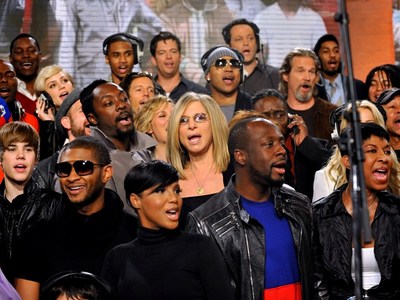(Akiit.com) A couple of days ago my colleagues at VIBE magazine were sharing their opinions in a webcast on the “We Are the World” remake, which both celebrates the song’s 25th anniversary and aims to raise money for Haiti. I decided to check out the video as I hadn’t seen it yet, and then sat with an influx of emotions as I wrapped my head around the newest incarnation of the pop classic penned by Michael Jackson and Lionel Richie, the original video of which I’d watched as a child.

The contemporary version of “We Are the World” features more artists and had the potential to feature more genres. Sure enough, a new hip-hop verse is thrown in towards the end, and it’s this portion of the song that stands out as being its own, grooving entity. Interestingly, even with the potential to use artists and sounds that could represent a wider palette of music, the song’s production speaks more to the commercial factory pop that’s currently de rigueur. It’s big and bombastic, befitting a song meant to unite billions.
Yet simplicity often has the greatest power when it comes to relaying connectedness. It’s one of the reasons why the original “We Are the World” holds more sway for me. That more straightforward tune placed seemingly disparate artists together to make something beautiful, taking us inside of ourselves. Some of the juxtapositions were jarring and humorous; Kenny Roger’s twang next to James Ingrams’ smoothness, or Cyndi Lauper wilding out on the bridge, the original’s biggest moment of bombast .
The newer version goes for more perpetual grandeur with its singers, and the video’s director Paul Haggis, interspersing scenes from Haiti, uses quick camera cuts to showcase the diversity of talent on hand. (Wyclef Jean garners the most attention for his trilling while the other performers have more conventional stylings.)
But something authentic feels sacrificed, that perhaps we’re in a time where artists feel less free to let performance be a more accurate reflection of inner worlds. The same trend was seen at the most recent Grammys, which had big performance after big performance, often with random artistic pairings, while some of the best moments were quieter and/or transcendent (the Les Paul tribute by Jeff Beck and Imelda May, or “Glitter in the Air“, by Pink, who also stands out in “World 25“). When everything’s loud and cluttered, it’s hard to get to that still, reflective place.
My reaction to the remake has less to do with the validity of the song or its contributors, and more to do with how it’s a marker of popular music’s direction today, also indicating my generational biases. Like Jay-Z, I’ve realized the original track has made a deep imprint on my heart, although I can still appreciate the new version for the great amount of good it’ll do for the impoverished.
The people of Haiti are the stars of the video, as we watch clips of people living with love among carnage and death, still being human and connected, dancing and singing, cameras on or not.
Written By Clarence Haynes









Leave a Reply